How to Write a Great Blurb for Your Self-Published Novel [With Examples]
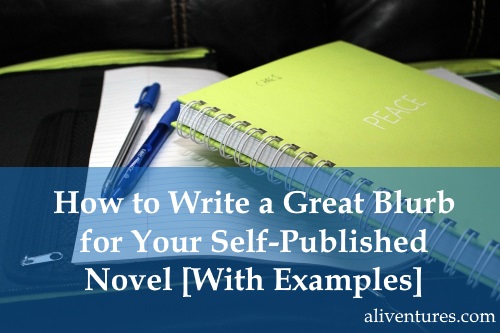
One of the more teeth-pulling tasks of self-publishing a novel is having to write your own blurb (or what Amazon calls a “product description”, and what some people call a “synopsis”).
I spent ages agonising over this when I published Lycopolis, including getting my writing group to take a look at my blurb and offer feedback.
To my surprise, it was really tricky to find advice on writing blurbs. I have a couple of shelves full of writing-related books – but none of them cover blurbs (several deal with the dreaded “synopsis” of the type you send to an agent, but not the type intended to sell books directly to readers).
Happily, I came across Bryan Cohen’s How to Write a Sizzling Synopsis a couple of months ago – more on that, and on my own total-blurb-rewrite in a moment.
Why the Blurb Matters
So why is your blurb so important?
#1: You Have Full Control Over It
Even as a self-pubishing author, you can’t control everything (much as you might want to!) You can’t control the reviews you get. You can’t control Amazon’s algorithms. You can, however, control your blurb – every word of it.
#2: Prospective Readers Will Read It
Even if not every reader reads the whole of your blurb, almost all will at least glance at it before they make a decision to buy (or not). Obviously, some authors could probably have a terrible blurb and people would still buy – Stephen King or J.K. Rowling, for instance – but for most authors, alongside the title, cover and reviews, the blurb is a key sales tool.
#3: The Blurb is Crucial for E-Book Sales
If you’re like me, you probably think of a blurb as “that bit on the back of a book”. For most self-published authors, it really doesn’t matter what’s on the back of a hardcopy of your book – people will only be reading that once they’ve already bought it from an online store! Don’t use this as an excuse to rush your blurb, though: it gives vital context for online shoppers who might well know nothing about you except that they saw a link to your book in a tweet or ad.
With almost any writing task, one of the best places to start is by looking at what other authors have done – and digging into why what they’ve done works. I’m going to run through three different blurbs, from three very different novels.
Examples of Blurbs (and Why They Work, Plus What Could be Tweaked)
Example #1: While My Eyes Were Closed, Linda Green – Amazon.com / Amazon.co.uk
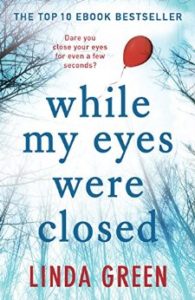 I’ve picked this book because (a) it was in the top 10 Kindle Books on Amazon and (b) I picked up Linda Green’s And Then It Happened… second-hand recently and enjoyed it.
I’ve picked this book because (a) it was in the top 10 Kindle Books on Amazon and (b) I picked up Linda Green’s And Then It Happened… second-hand recently and enjoyed it.
Here’s the blurb:
***
THE #1 EBOOK BESTSELLER. ‘A beautifully crafted novel of knife-edge suspense’ Amanda Prowse. A nail-biting psychological drama for fans of Room, Behind Closed Doors and Between You and Me.
One, two, three . . . Lisa Dale shuts her eyes and counts to one hundred during a game of hide-and-seek. When she opens them, her four-year-old daughter Ella is gone. Disappeared without a trace. The police, the media and Lisa’s family all think they know who snatched Ella. But what if the person who took her isn’t a stranger? What if they are convinced they are doing the right thing? And what if Lisa’s little girl is in danger of disappearing forever?
***
A surprising number of the top 100 Kindle Books on Amazon fall into the “thriller” – particularly “psychological thriller” category. I wonder whether that’s because they lend themselves to good blurbs.
This blurb starts in a very relatable way – playing hide and seek with a child – then quickly takes a twist: “Ella is gone.” There are hints of a mystery (“what if the person who took her isn’t a stranger?”) and clear high-stakes – “in danger of disappearing forever”.
There’s not much detail about the plot: we don’t know who “Lisa’s family” involves, and we’ve no idea why someone would be convinced that snatching a four-year-old would be “the right thing”. But the blurb is engaging enough to make the reader wonder what’s going to happen.
Example #2: The Assistants, Camille Perri – Amazon.com / Amazon.co.uk
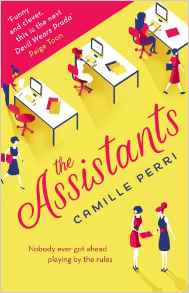 I bought The Assistants on the strength of a BookBub ad and its blurb (plus good reviews and a look at the first couple of pages) … so I wanted to include it here.
I bought The Assistants on the strength of a BookBub ad and its blurb (plus good reviews and a look at the first couple of pages) … so I wanted to include it here.
***
‘Funny and clever, this is the next Devil Wears Prada‘ Paige Toon
Behind every successful man is a busy assistant and Tina’s boss is very successful.
But Tina is tired of being overworked and underpaid.
She’s bored of her damp flat and her mounting debts.
Then a blip in the expenses system sends Tina a cheque.
She’s a good person.
But she’s desperate.
This isn’t stealing.
It’s an administrative error.
Right?
What would you do if you thought you’d get away with it?
***
While I’m not massively keen on the now-ubiquitous “for fans of…” in blurbs, it can help to instantly give people an idea of the tone or content of your work, as with “this is the next Devil Wears Prada” here.
Again, the blurb doesn’t give a huge amount of detail – we don’t know anything about Tina’s boss except that he’s “very successful”, and we don’t know much about Tina. We do know, however, that she’s a good person in a difficult situation … and we want to find out what she’ll do.
There’s a very strong hook at the end of the blurb: “What would you do if you thought you’d get away with it?” Quite a lot of blurbs use questions directly to the reader like this, essentially encouraging them to step into the shoes of the protagonist; some even present the whole blurb in the second person, as Behind Closed Doors does. (The Assistants isn’t a thriller, but thrillers seem particularly fond of this technique.)
Example #3: Off to Be the Wizard, Scott Meyer – Amazon.com / Amazon.co.uk
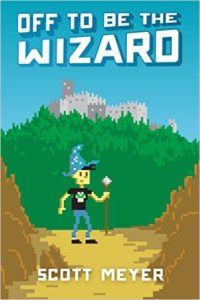 I wrote about the thought process behind purchasing this one in How Do Readers Choose YOUR Book From a Million Other Choices? The Story of a Book Purchase – as I described there, the blurb was (for me) one of the main selling points:
I wrote about the thought process behind purchasing this one in How Do Readers Choose YOUR Book From a Million Other Choices? The Story of a Book Purchase – as I described there, the blurb was (for me) one of the main selling points:
***
An io9 Can’t Miss Science Fiction and Fantasy title in March 2014.
Martin Banks is just a normal guy who has made an abnormal discovery: he can manipulate reality, thanks to reality being nothing more than a computer program. With every use of this ability, though, Martin finds his little “tweaks” have not escaped notice. Rather than face prosecution, he decides instead to travel back in time to the Middle Ages and pose as a wizard.
What could possibly go wrong?
An American hacker in King Arthur’s court, Martin must now train to become a full-fledged master of his powers, discover the truth behind the ancient wizard Merlin…and not, y’know, die or anything.
***
One of the things I like most about this blurb is that a sense of the author’s voice comes through: there’s a definite touch of humour (“what could possibly go wrong?” and “not, y’know, die or anything”). There’s also a neatly-done reference to Mark Twain’s A Connecticut Yankee in King Arthur’s Court.
There’s no mention of characters other than Martin (apart from Merlin, who readers are presumably already familiar with): this helps keep the focus on him, and avoids confusing the reader. If you look at the other two examples, The Assistants only names Tina (not her boss, not any other characters involved) and While My Eyes Were Closed names only two characters, Lisa and Ella.
Writing or Rewriting Your Own Blurb
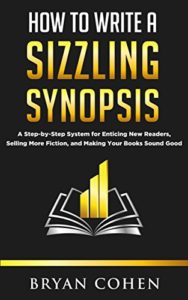 So, how do you write a good blurb for your book? First, I’d strongly recommend getting a copy of Bryan Cohen’s book How to Write a Sizzling Synopsis (Amazon.com / Amazon.co.uk). I picked this up when it was launched, just over a month ago.
So, how do you write a good blurb for your book? First, I’d strongly recommend getting a copy of Bryan Cohen’s book How to Write a Sizzling Synopsis (Amazon.com / Amazon.co.uk). I picked this up when it was launched, just over a month ago.
This book wasn’t what prompted me to rewrite my blurb, though. A few weeks ago, I experimented with Facebook ads for the first time, and ran my first (and so far only!) ad for my novel Lycopolis. I got a reasonable click-through rate, but didn’t make many sales – effectively, I was paying to have my book read.
Quite a few (complete strangers) “liked” my ad, which was nice. Then one disgruntled Facebook user left a comment:

Ouch!
On the bright side, this helped confirm my suspicion that my blurb was in need of some serious work.
Inspired by Bryan’s book (I literally sat down and rewrote the blurb as soon as I finished reading it), here’s the before and after of my Lycopolis blurbs:
Previous Version
 One Hallowe’en, a group of online roleplayers summon a demon, The Prince of Nightmares. Seth, who’s in charge of the game, says it’s “just for fun”. But disturbing things start to happen in real life: red marks appear on the foreheads of the gamers, and they’re all having nightmares about a dark forest.
One Hallowe’en, a group of online roleplayers summon a demon, The Prince of Nightmares. Seth, who’s in charge of the game, says it’s “just for fun”. But disturbing things start to happen in real life: red marks appear on the foreheads of the gamers, and they’re all having nightmares about a dark forest.
Secrets come out, friendships are broken, and the boundaries between the real, the virtual and the imaginary become increasingly fractured as the Prince becomes more powerful. Kay, a student at Oxford, is the only person who realises what Seth is doing – and it’s up to her to stop him.
New Version
Seth’s got a lot going for him: money, charm, and Lycopolis – a niche online game where he can play god.
He wants more.
Much more.
For years, there’s been a little voice in the back of his head, urging him on.
For months, he’s been crafting the game, getting everything just right.
And for days, he’s been waiting for the perfect moment to summon a demon.
He makes it easy for his handpicked group of Lycopolis players. Ties it in with Hallowe’en – a bit of fun, a spooky twist to the story they’re jointly telling.
Only one of them refuses to join in: Kay.
Frankly, he didn’t think she had it in her. She’s diffident, unimposing. And he can tell she fancies him.
But, as he wrestles with power and faces the darkness, she’s the one who keeps getting in the bloody way.
Of course, he wins. He always wins.
Except this time, he wishes he hadn’t. Because something ancient and evil, something that’s been whispering in his ear for fifteen years – and whispering to mankind for much, much longer – has been playing him all along.
By the time he understands just what’s at stake, it’s almost too late … and even Kay might not able to save him.
***
I feel like – compared with the above examples, at least — this blurb is probably a bit long, and I’ll doubtlessly tweak it some more … but it’s a considerably improvement on the original one. (If you have suggestions for further improvement, do feel free to leave a comment!)
(By the way, if the new improved blurb has inspired you to check out the book, you can find it here on Amazon.com, here on Amazon.co.uk, or on your local version of Amazon. It’s currently free to borrow for Kindle Unlimited subscribers.)
So, how did I change it?
#1: I Followed Bryan’s Step-by-Step Instructions to Get Started
In Chapter 8 How to Write a Sizzling Synopsis, Bryan Cohen lays out a helpful seven step plan for writing a blurb. He stresses that this is far from the only way to write a blurb, and once I’d got a couple of steps in, I felt comfortable going off on my own! But it was a real help to have a clear way to get started.
#2: I Stopped Worrying About “Summarising”
One of the most important takeaways from Bryan’s book, for me, was that your blurb is not a summary of your novel. It’s more like a teaser or taster. It should entice the reader – it’s not a dry, factual account. Once I’d got that into my head, the whole task of “write a blurb” was much easier.
#3: I Put More Voice and Character Into the Blurb
I wanted to give the readers a sense of character and voice, something a bit more engaging than just a here’s-the-facts sort of blurb, and so I essentially wrote this blurb in the limited-third-person. I’d originally been planning to bring Kay’s perspective in too – but I felt that was going to over-complicate things.
As you write – or rewrite – your blurb, I’d suggest:
- Pick one character to focus on, even if (like me) you don’t necessarily have a single protagonist or you have multiple viewpoint characters.
- Name one character, possibly two; avoid giving more names than two unless it’s absolutely necessary (and to be honest, it’s unlikely to be).
- Think about your central concept or hook: what kicks the story off, in the first few chapters? E.g. in Lycopolis, it’s summoning a demon; in K.M. Weiland’s Storming, it’s a strange girl falling from the sky.
- Create questions or mini-cliff-hangers: you want the reader to be wondering what’s going to happen next, or how everything’s going to play out.
You might want to write two or three very different versions, and run them past your beta-readers to see which (a) work best as blurbs alone and (b) successfully give a sense of what your novel is like.
Best of luck with your blurb – and if you’ve got a question, suggestion, or resource to recommend, just let me know in the comments.
About

I’m Ali Luke, and I live in Leeds in the UK with my husband and two children.
Aliventures is where I help you master the art, craft and business of writing.
Start Here
If you're new, welcome! These posts are good ones to start with:
Can You Call Yourself a “Writer” if You’re Not Currently Writing?
The Three Stages of Editing (and Nine Handy Do-it-Yourself Tips)
My Novels
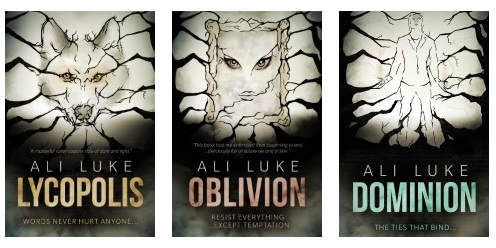
My contemporary fantasy trilogy is available from Amazon. The books follow on from one another, so read Lycopolis first.
You can buy them all from Amazon, or read them FREE in Kindle Unlimited.
7 Comments
Trackbacks/Pingbacks
- Monday Must-Reads [08.29.16] - […] How to Write a Great Blurb for Your Self-Published Novel [With Examples] – Aliventures […]
- Five Links Friday 9/9/16 | Write Good Books - […] Ali Luke has a great article on her blog about How to Write a Great Blurb for Your Self-Published…

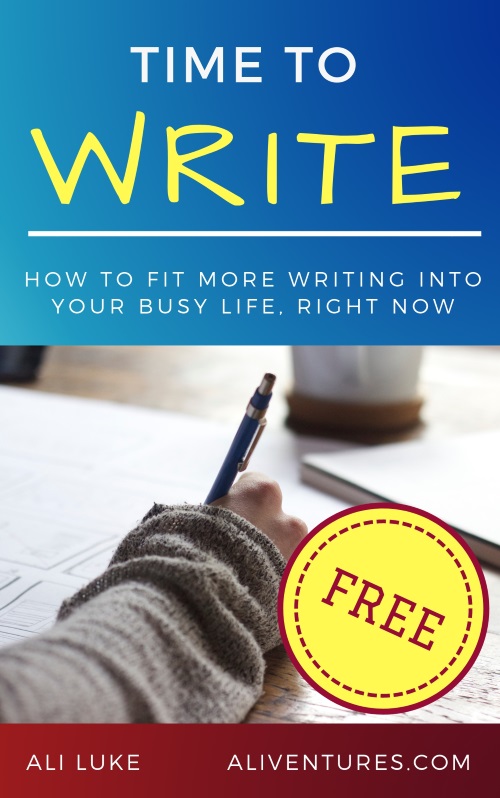
Hi! This article is really great. About the blurb for Lycopolis, this is my entirely subjective opinion, but I think you’re absolutely right about the length, it kind of kills the effect, to the point that -again, my subjective personal opinion- although I can see what was wrong with the old blurb, I felt it was more powerful because it had rhythm to it, which I feel the new one lacks because of its length and line breaks (nothing kills the rhythm of a text like line breaks every sentence). I’ve read the novel and the sequel (can’t wait for the third book!) and enjoyed them a lot. It does deserve a strong blurb 🙂 I hope you can come up with one that you like 🙂
Thanks, Pwassonne! And thank you for the honest (and gently worded) feedback, which is hugely appreciated. So glad you enjoyed Lycopolis & Oblivion! I’ll have another go at the blurb. I did wonder if the line breaks were a bit much…!
Hi Ali 🙂
Just read this off a link from Twitter. Way to go finding the energy to rewrite your blurb. The new one is definitely much better. This said, I agree with you–the length of the new one is too long. And I agree with the comments posted by Pwassonne.
If I can add my own suggestions? (I’m not an editor, nor an author, and at this moment, I am working towards writing my first stuff, so take what i say with a grain of salt maybe, and imagine it as being from my experience as a reader if nothing else.)
I loved it from “Seth’s got a lot going for him [..]” to “Much more.” (Though I’d probably remove the line break between the last two sentences.)
But then it gets to be kind of too much. If you can condense the next lines.. (And I’m not trying to do it for you, but something more rhythmic yet shorter….)
“Seth’s got a lot going for him: money, charm, and Lycopolis – a niche online game where he can play god.
He wants more. Much more.
For years, a little voice has urged him on. Now, the game is ready. With Halloween around the corner, the time has come for the players he has recruited to enjoy a spooky twist to the story they’ve been playing out. Only, one of them refuses to join in.
Frankly, he didn’t think Kay had it in her. She’s diffident, unimposing, and he can tell she fancies him. Yet she keeps getting in his way.
Seth doesn’t know it yet, but he’s been played by an ancient force of tremendous evil. By the time he understands just what’s at stake, it’s almost too late … and even Kay might not able to save him.”
Maybe something more like that. Same words, only condensed. Because the words are really well chosen and dramatic!
So, thanks for the help, advice, and resource, and also I’m glad I read Pwassonne’s review of your other two books… Sounds like something my son would enjoy. Good luck, and keep up the hard work! 😀
Thanks so much, Elisa! Your suggestions are both super-appreciated and super-helpful. 😀
(Excuse the horribly slow reply, been away for a week’s holiday — with kids and husband — at my parents’ with limited internet access and I missed your comment!)
Hey Ali,
Love the blog. We publish links to your posts all the time in our weekly feature The Scoop. Anyhoo, noticed this post in particular because we had a guest writer do a post on the exact same subject (http://www.knockinbooks.com/blog/book-blurbs-selling-the-story-vs-telling-the-story). Loved your take on the topic too. Keep up the great work.
What a brilliant post, Scott — I wish I’d read it years ago! And the links from The Scoop are very much appreciated … thank you so much! 🙂
Thanks for this helpful post! It was easier to write the darned book than it is to write a blurb, elevator pitch, OR synopsis.